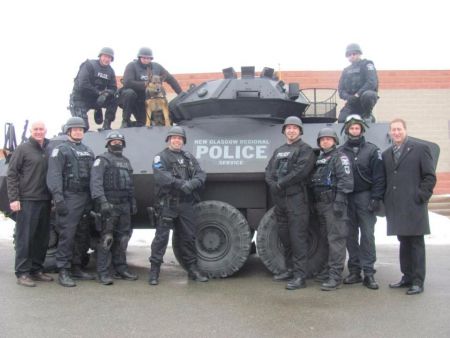This photo of the Emergency Response Team (ERT) of the New Glasgow police service provides a starting point for some important insights into the workings of the Canadian settler state.
The tank-like vehicle is called a cougar, and was recently acquired by the New Glasgow police through a department of defence program that gives away old military equipment to police. One article said the RCMP refer to it as "cougars for cops". There is a very similar program in the US that is much larger and has gotten more attention (the 1033 program).
This is one very obvious part of a broader process over the past few decades of police and military learning from one another and becoming less distinct, as both increasingly become forces of counter-insurgency. "The other side of the COIN" is an excellent article on this by Kristian Williams.
For example, in 2010 it was reported the the Montreal police (the SPVM) were getting training from the Canadian Forces. After police officers shot and killed an unarmed man named Fredy Villanueva, things didn't go well for them during the riots in his community of Montreal Nord. They approached the military to find out how they deal with injuries in a battlefield. In return, the SPVM would share their crowd control expertise to help the Canadian Forces deal with riots in Afganistan.
Back to New Glasgow, how did small town police get hooked up with a federal surplus equipment program? Well, the suit on the right-hand side of the photo is Peter MacKay, MP for the area and also minister of national defence. That's the surface-level answer, but it's in a colonial context that's important to highlight.
Cougar vehicles were acquired through the same department of defence program in early 2010 by the RCMP in Vancouver. The CBC article about that acquisition was helpful in pointing out that the only time the RCMP in British Columbia had ever needed vehicles of this kind before was in 1995 at Ts'peten (Gustafen Lake) when they borrowed them from the Canadian Forces during a massive paramilitary seige on a handful of indigenous land defenders and supporters.
Since the defence of the pines at Kanehsatake in 1990, the various levels of the Canadian state seem to have tried to avoid direct military involvement in the repression of indigenous resistance. The borrowing of military equipment by the RCMP in 1995 was one way of doing this, and militarizing the police is another. This should be considered when looking at the police in New Glasgow.
There are active Mi'kmaq land defenders in communities very near to New Glasgow. For example, just last fall Mi'kmaq warriors from nearby communities led partial highway blockade protests against oil and gas drilling at Lake Ainslie, just two hours drive from the town.
The New Glasgow police said the cougar will be used to "ensure officer safety in dangerous situations." Given the colonial history of policing in Canada, it's hard not to think that the repression of indigenous land defenders is one of the situations they have in mind.



